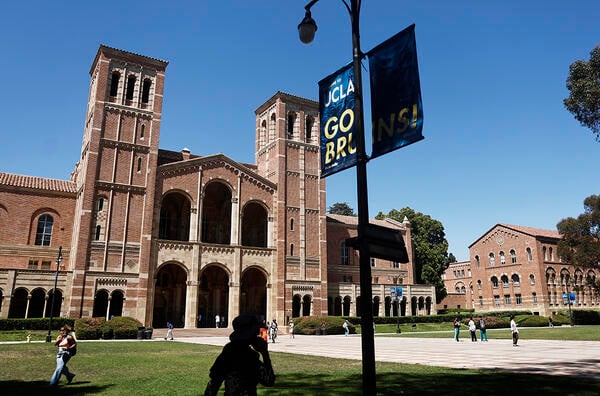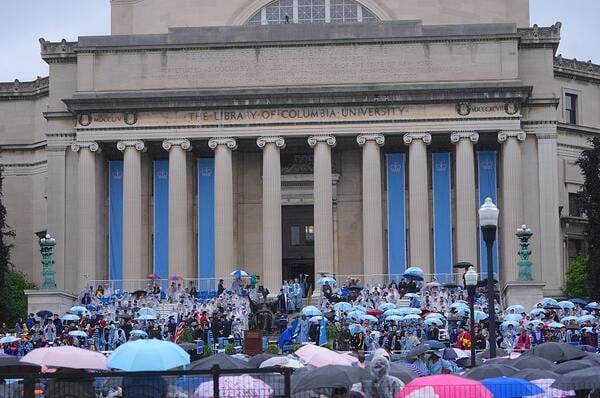The Trump administration announced last week it was freezing federal grants for another prestigious research university. But this time, it wasn’t a private institution.
It was the University of California, Los Angeles, and if the UC system doesn’t make a deal with the federal government, campuses across one of the nation’s largest public higher education systems might incur the administration’s further punishment. State leaders condemned the funding freeze, and faculty at UCLA are urging university administrators to fight. But the university has said little about how it plans to respond to the administration.
The Department of Justice has been investigating the University of California system for months—looking into alleged antisemitism, alleged use of race in admissions and “potential race- and sex-based discrimination in university employment practices.” The agency’s investigations into the broader UC system are still ongoing, but last week, the DOJ told system officials it had made a finding regarding one campus and demanded a quick response.
“The Department has concluded that UCLA’s response to the protest encampment on its campus in the spring of 2024 was deliberately indifferent to a hostile environment for Jewish and Israeli students in violation of the Equal Protection Clause and Title VI,” the letter said. (Title VI of the Civil Rights Act of 1964 prohibits universities that receive federal funding from discriminating based on shared ancestry, including antisemitism.)
The letter didn’t specifically say what the Trump administration wants UC to do now about its alleged failure to handle a pro-Palestine encampment that ended more than a year ago, and that UCLA itself dismantled a week after its creation. The DOJ didn’t provide Inside Higher Ed further information Monday, but U.S. attorney general Pam Bondi’s news release accompanying the DOJ letter suggests the Trump administration wants significant concessions.
“Our investigation into the University of California system has found concerning evidence of systemic anti-Semitism at UCLA that demands severe accountability from the institution,” Bondi said. “This disgusting breach of civil rights against students will not stand: DOJ will force UCLA to pay a heavy price for putting Jewish Americans at risk and continue our ongoing investigations into other campuses in the UC system.”
Just hours before the DOJ’s announcement, UCLA had announced that it was paying $6.45 million to settle a lawsuit from Jewish students over reported antisemitism associated with the encampment. But that wasn’t enough to assuage the federal government.
The DOJ letter said the department “seeks to enter into a voluntary resolution agreement with the university to ensure that the hostile environment is eliminated and reasonable steps are taken to prevent its recurrence.” It asked the UC officials to contact a special counsel by today if they were “interested in resolving this matter along these lines,” providing an email address and a nonfunctional nine-digit phone number for them to contact. The agency is prepared to sue by Sept. 2 “unless there is reasonable certainty that we can reach an agreement.”
That July 29 letter wasn’t the end of it. In the week between then and today’s deadline for UC to contact the DOJ, multiple federal agencies said they’re cutting off grants to UCLA. The total amount is unclear—other media have reported numbers exceeding $300 million.
It’s reminiscent of what happened at Columbia and Harvard Universities. But unlike with those private institutions, the Trump administration hasn’t published an overarching demand letter for how it wants UCLA to change its ways, whether in admissions, student discipline or otherwise.
A spokesperson for the Department of Health and Human Services, which includes the National Institutes of Health, responded to Inside Higher Ed’s requests for information on how much in NIH grant funding has been canceled and why with a two-line response attributed to an unnamed HHS official: “We will not fund institutions that promote antisemitism. We will use every tool we have to ensure institutions follow the law.”
A National Science Foundation spokesperson wrote in an email that the NSF “informed the University of California, Los Angeles that the agency is suspending awards to UCLA because they are not in alignment with current NSF priorities and/or programmatic goals.” The spokesperson didn’t specify which priorities or which goals, and his email didn’t mention antisemitism.
The Department of Energy went beyond allegations of antisemitism in its letter to UCLA, saying that “UCLA engages in racism, in the form of illegal affirmative action” and UCLA “endangers women by allowing men in women’s sports and private women-only spaces.”
Mia McIver, executive director of the national American Association of University Professors, said what’s happening is the “Trump administration is extending its pattern of attacking higher education faculty, staff and students more broadly outward from the Ivy League universities into the public sector.” McIver, who taught at UCLA for a decade, said the administration intends to “exercise pervasive control over colleges and universities in every region of every different sort of institution.”
“It is the federal government using levers of power that are completely unrelated to the underlying allegations,” McIver said. “Cutting off research for diabetes, cancer, heart disease will not improve the safety of Jewish faculty and students on campus and will not address antisemitism.”
‘Enough Is Enough’
What does the UC system plan to do? A spokesperson deferred comment to UCLA, which also didn’t provide interviews Monday or answer written questions. The UC system spokesperson did forward a statement Friday from system president James B. Milliken, who started in his new job Aug. 1—just after the grant freezes.
Milliken called “the suspension this week of a large number of research grants and contracts” at UCLA “deeply troubling,” though “not unexpected.”
“The research at UCLA and across UC more broadly saves lives, improves national security, helps feed the world, and drives the innovation economy in California and the nation,” he said. “It is central to who we are as a teaching and learning community. UC and campus leadership have been anticipating and preparing for the kind of federal action we saw this week, and that preparation helps support our decisions now.”
He didn’t, however, say what the decisions would be.
Also Friday, California governor Gavin Newsom, a potential 2028 presidential candidate and an ex officio member of the UC Board of Regents, released a statement calling it “a cruel manipulation to use Jewish students’ real concerns about antisemitism on campus as an excuse to cut millions of dollars in grants that were being used to make all Americans safer and healthier.”
“This is the action of a president who doesn’t care about students, Californians, or Americans who don’t comply with his MAGA ways,” Newsom said.
UCLA chancellor Julio Frenk said in a video on X Friday that “we share the goal of eradicating antisemitism. It has no place on our campus or in our society.” He said his wife is the daughter of a Holocaust survivor, and his paternal grandparents left Germany in the 1930s after being “driven out of their home by an intolerable climate of antisemitism and hate.”
“These experiences inform my own commitment to combating bigotry in all its forms, but a sweeping penalty on lifesaving research doesn’t address any alleged discrimination,” Frenk said. He said, “We have contingency plans in place,” though he didn’t elaborate.
In a petition, the UCLA Faculty Association’s Executive Board criticized UCLA administrators for their past “anticipatory obedience” to the federal government, which it said “has not prevented Trump administration attacks.”
“UCLA’s anticipatory obedience has put itself in a place of weakness and we must instead choose to stand up,” the association wrote. “We do not have to bend to the Trump administration’s illegitimate and bad-faith demands. UCLA is a state university, with the financial backing and moral support of the fourth-largest economy in the world.”
The association demanded that UC “demonstrate our strength as the world’s largest university system and reject the malicious demands of the Trump administration,” adding that “each university that falters legitimates the Trump administration’s attacks on all of our institutions.”
It called for UC to fight the administration in court, to use unrestricted endowment funds to “help keep our university’s mission intact” and to work with Newsom and state lawmakers to get financial support. The petition ended with a call for university administrators to not “sacrifice our strengths and our community, deeply nurtured and protected for over 100 years, to a deeply callous and unfair federal administration that will only ask for more.”
Meanwhile, Faculty for Justice in Palestine at UCLA said in a statement that “Israel continues to tighten its US-enabled siege of Gaza, where the calculated denial of humanitarian assistance is causing mass starvation amid ongoing aerial bombing. The theatrics of the Trump administration, echoed by UCLA, are part of a larger attempt to cover up this genocidal catastrophe in which all of us, and our university, are complicit.”
McIver urged the UC system not to cut deals like Columbia and Brown Universities have.
“There are always alternatives,” she said, “and every deal that is cut makes it harder for those who are downstream of the deal to continue resisting these attacks.”
“The Trump administration is aiming to control colleges and universities at all levels in all states, and every settlement that is reached basically contributes to that goal,” she said. “And so there has to be a point at which everyone across the country stands up and says, ‘Enough is enough, we’re not going to tolerate this extortion, you can’t hold our campuses hostage and we’re not going to take it anymore.’”



